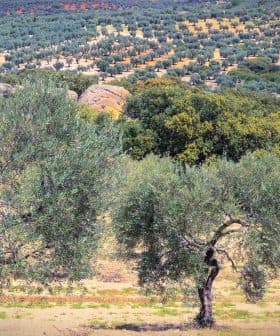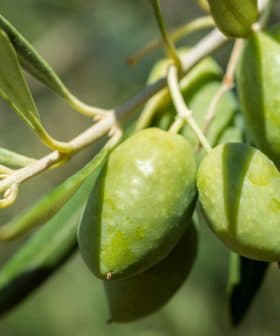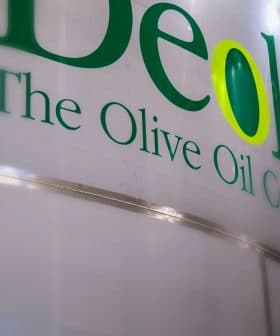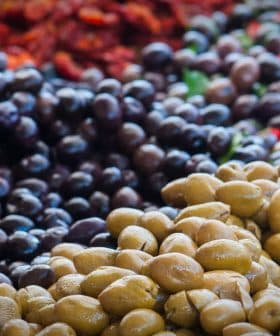Some Hope for Growers as Rain Falls in Andalusia
For many producers in southern Spain, too little rain has fallen too late, with expectations of another poor harvest looming. Still, the rain lifted expectations.
 Oro del Desierto's olive groves in Almería
Oro del Desierto's olive groves in Almería Despite some recent rain in Andalusia, the ongoing drought has not been fully alleviated, with the region still experiencing below-average water levels. The rain has not been enough to significantly improve the harvest outlook, leading to concerns about the quality and quantity of olive oil production in the coming year.
After months of anticipation, the rain finally came to Andalusia, the world’s largest olive oil-producing region.
However, the light showers that fell across the south of Spain have not been enough to counteract the effects of the ongoing drought.
In the whole of Andalusia, the forecasts are bad due to the prolonged drought that has negatively affected flowering… I can say that Andalusia will once again have a rather low harvest for the second consecutive year.
Local media reported that in Jaén, Andalusia’s most prolific olive-growing province, high temperatures and the strong sun emerged after nearly two weeks of rain in which less than 100 liters of water fell per square meter.
The mountainous east and west of the province reportedly received the most precipitation, and Spain’s state meteorological agency, Aemet, expects a little more rain to fall in the coming weeks.
See Also:2023 Harvest UpdatesThe prevailing wisdom among meteorologists and olive growers is that at least a month of these rains would be needed to reach normal levels in the hydrological year.
“The outlook for the existing harvest has been strengthened at least temporarily by the rains, although they were insufficient,” Juan Vilar, a strategic consultant based in Jaén, told Olive Oil Times.
He added that more rain is expected in June and forecasted for the autumn, further improving the harvest outlook.
However, the effects of Spain’s devastating drought have already taken their toll on the olive groves, and Vilar expects the harvest will not fully recover from last year’s historic low.
According to data from Aemet, an average of 371 millimeters of rain have fallen across Spain since the start of the hydrological year in October 2022, 27 percent lower than the average amount of rain expected by Spain.
Most of southern and eastern Spain, including three of the fourth largest olive oil-producing regions (Andalusia, Castille-La Mancha and Catalonia), has received less than 300 millimeters of rain in the hydrological year.
While olive trees can survive on less than 200 millimeters of rain annually, most olive trees for oil production require between 400 and 1,000 millimeters annually for optimal productivity.
Rain has also not fallen evenly and has yet to significantly raise the levels of aquifers and reservoirs, many of which still sit at historic lows.
According to data from the Ministry for the Ecological Transition and Demographic Challenge cited by the Jaén chapter of the Association of Young Farmers and Ranchers (Asaja), water reserves across Spain sits at slightly less than 50 percent of total capacity.
Despite the rain, water levels in the Guadalquivir basin, partially located in Andalusia, fell to 23.8 percent, a 0.2 percent decrease compared to the week before and significantly below last year’s levels and those of the 10-year average.
Ministry data shows that 16 of Spain’s 17 watershed areas are below the 10-year average. Meanwhile, ten are at lower capacity than last year, with much of the reprieve coming for watersheds in the country’s north, which has a historically wetter climate.
Immediately after the rainfall at the end of May, olive oil prices at origin dipped slightly but have since returned to record highs, with production expectations for the 2023/24 crop year lower than the historical average would suggest they should be.
In its weekly report, Andalusia’s Ministry of Agriculture, Fisheries, Water and Rural Development said that while many of the region’s olive groves are entering fruitset, a significant number of groves of Picual trees in eastern Jaén would not come to fruition after the flowers were lost.
The regional ministry also reported that in groves where fruit set had taken place, farmers were seeing noticeably smaller olives, some “the size of a pinhead,” and concluded that “expectations are not good,”, especially in groves around Úbeda, Baeza and Mancha Real where “flowering has been bad.”
East of Jaén in the nearby province of Almería, Rafael Alonso Barrau, the commercial and export director of Oro del Desierto, said he received little reprieve from the rain.
He told Olive Oil Times that dry weather and high heat in April resulted in a low-quality bloom in Almería. When the rain came in mid-May, it brought hail, and Alonso said this also damaged many of the trees.
“In the whole of Andalusia, the forecasts are bad due to the prolonged drought that has negatively affected flowering,” he said. “This clashes with news of better world forecasts compared to last year.”
“I can say that Andalusia will once again have a rather low harvest for the second consecutive year,” Alonso concluded.
Share this article









